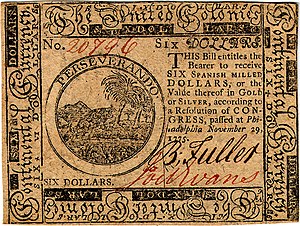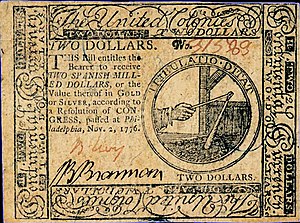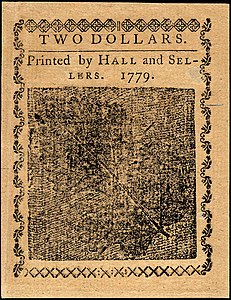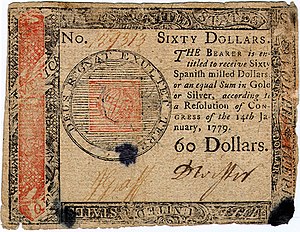
The Australian dollar is the official currency and legal tender of Australia, including all of its external territories, and three independent sovereign Pacific Island states: Kiribati, Nauru, and Tuvalu. As of 2022, it is the sixth most-traded currency in the foreign exchange market and also the seventh most-held reserve currency in global reserves.
The 1st New Hampshire Regiment was an infantry unit that came into existence on 22 May 1775 at the beginning of the American Revolutionary War. John Stark was the regiment's first commander. The unit fought at Chelsea Creek and Bunker Hill in 1775. On 1 January 1776, while engaged in the Siege of Boston, the unit was renamed the 5th Continental Regiment. In the spring it was sent to Canada where the New Hampshire soldiers fought at Trois-Rivières and later helped defend the area around Lake Champlain. Late in the year, the 5th Continental Regiment was transferred south to George Washington's main army where it fought at Trenton.
The 1st Massachusetts Regiment was an infantry unit of the Continental Army that fought during the American Revolutionary War. It was first authorized on 23 April 1775 in the Massachusetts State Troops as Paterson's Regiment under Colonel John Paterson and was organized at Cambridge, Massachusetts. It consisted of eleven companies of volunteers from Berkshire, Hampshire, Suffolk, Middlesex, Worcester, and York counties in Massachusetts and the county of Litchfield in the colony of Connecticut. The regiment was adopted into the main Continental Army on 14 June 1775 and was assigned to William Heath's brigade on 22 July 1775. On 1 January 1776 the regiment was consolidated with Sayer's and Sullivan's companies of Scammon's Regiment; re-organized to eight companies and redesignated as the 15th Continental Regiment of Heath's Brigade.
The 7th Massachusetts Regiment was an infantry regiment of the Continental Army. It was constituted on 16 September 1776, and was originally known as Alden's Regiment after its first colonel, Ichabod Alden. It was organized as seven companies of volunteers from across Massachusetts, and Mayhew's company from the 25th Continental Regiment during the later months of 1776. The regiment was assigned to the Northern Department on 9 February 1777. It was reassigned to the Highland's Department on 13 March 1777. On 12 June 1777 it was assigned to 2nd Massachusetts Brigade and three days later, 15 June 1777, it was reassigned to the 1st Massachusetts Brigade. The brigade was reassigned to the Northern Department on 1 July 1777 and the regiment was relieved from the brigade on 31 March 1778. The regiment re-organized to nine companies on 25 September 1778 and reassigned to the Northern Department on 14 June 1779. The regiment was reassigned to the New Hampshire Brigade of the main army on 23 August 1779. On 14 November 1779, the regiment was reassigned to the 3d Massachusetts Brigade in the Highland Department. On 1 January 1781, the regiment was reassigned to the 1st Massachusetts Brigade. The regiment was furloughed on 12 June 1783 at West Point, New York and disbanded on 15 November 1783.

The 1st Rhode Island Regiment was a regiment in the Continental Army raised in Rhode Island during the American Revolutionary War (1775–83). It was one of the few units in the Continental Army to serve through the entire war, from the siege of Boston to the disbanding of the Continental Army on November 3, 1783.

The 3rd Connecticut Regiment was authorized on 16 September 1776 and was organized between 1 January - April 1777 of eight companies of volunteers from the counties of Windham and Hartford in the state of Connecticut.
The 1st North Carolina Regiment of the Continental Army was raised on September 1, 1775, at Wilmington, North Carolina. In January 1776 the organization contained eight companies. Francis Nash was appointed colonel in April 1776. The regiment was present at the defense of Charleston in 1776. It transferred from the Southern Department to George Washington's main army in February 1777. At that time, Thomas Clark became colonel of the 1st Regiment. The regiment became part of General Francis Nash's North Carolina Brigade in July.
The 3rd South Carolina Regiment was an infantry regiment of the South Carolina Line during the American Revolutionary War. Raised in the western part of South Carolina, the regiment fought in the Siege of Savannah and the Siege of Charleston, surrendering to British forces in the latter.

The Connecticut Line was a formation within the Continental Army. The term "Connecticut Line" referred to the quota of numbered infantry regiments assigned to Connecticut at various times by the Continental Congress, the size of its allocation determined by the size of its population relative to that of other states. These, together with similarly apportioned contingents from the other twelve states, formed the Continental Line. The concept was particularly important in relation to the promotion of commissioned officers. Officers of the Continental Army below the rank of brigadier general were ordinarily ineligible for promotion except in the line of their own state.

The North Carolina Line refers to North Carolina units within the Continental Army. The term "North Carolina Line" referred to the quota of infantry regiments assigned to North Carolina at various times by the Continental Congress. These, together with similar contingents from the other twelve states, formed the Continental Line. The concept was particularly important in relation to the promotion of commissioned officers. Officers of the Continental Army below the rank of brigadier general were ordinarily ineligible for promotion except in the line of their own state.

The Virginia Line was a formation within the Continental Army. The term "Virginia Line" referred to the quota of numbered infantry regiments assigned to Virginia at various times by the Continental Congress. These, together with similar contingents from the other twelve states, formed the Continental Line. The concept was particularly important in relation to the promotion of commissioned officers. Officers of the Continental Army below the rank of brigadier general were ordinarily ineligible for promotion except in the line of their own state.

Stephen Moylan was an Irish-American patriot leader during the American Revolutionary War. He had several positions in the Continental Army, including Muster-Master General, Secretary and Aide to General George Washington, 2nd Quartermaster General, Commander of the Fourth Continental Light Dragoons, and Commander of the Cavalry of the Continental Army.

The Maryland and Virginia Rifle Regiment, most commonly known as Rawlings' Regiment in period documents, was organized in June 1776 as a specialized light infantry unit of riflemen in the Continental Army during the American Revolutionary War. The American rifle units complemented the predominant, musket-equipped, line infantry forces of the war with their long-range marksmanship capability and were typically deployed with the line infantry as forward skirmishers and flanking elements. Scouting, escort, and outpost duties were also routine. The rifle units' battle formation was not nearly as structured as that of the line infantry units, which employed short-range massed firing in ordered linear formations. The riflemen could therefore respond with more adaptability to changing battle conditions.

The Enterprise-class frigates were the final class of 28-gun sailing frigates of the sixth-rate to be produced for the Royal Navy. These twenty-seven vessels were designed in 1770 by John Williams. A first batch of five ships were ordered as part of the programme sparked by the Falklands Islands emergency. Two ships were built by contract in private shipyards, while three others were constructed in the Royal Dockyards using foreign oak.
Washington's aides-de-camp during the American Revolutionary War were officers of the Continental Army appointed to serve on General George Washington's headquarters staff, with the rank of lieutenant colonel. The headquarters staff also included one military secretary, a full colonel.
North Carolina state troops in the American Revolution were the initial military units created in a transition from the Province of North Carolina under British rule to independence from British rule. Most units did not last long as such and were either transferred to the Continental Army or state militia instead.

The Continental Currency dollar coin was the first pattern coin struck for the United States. The coins, which were designed by Benjamin Franklin, were minted in 1776 and examples were made on pewter, brass, and silver planchets.
The following outline is provided as an overview of and topical guide to the American Revolutionary War.









































































































































